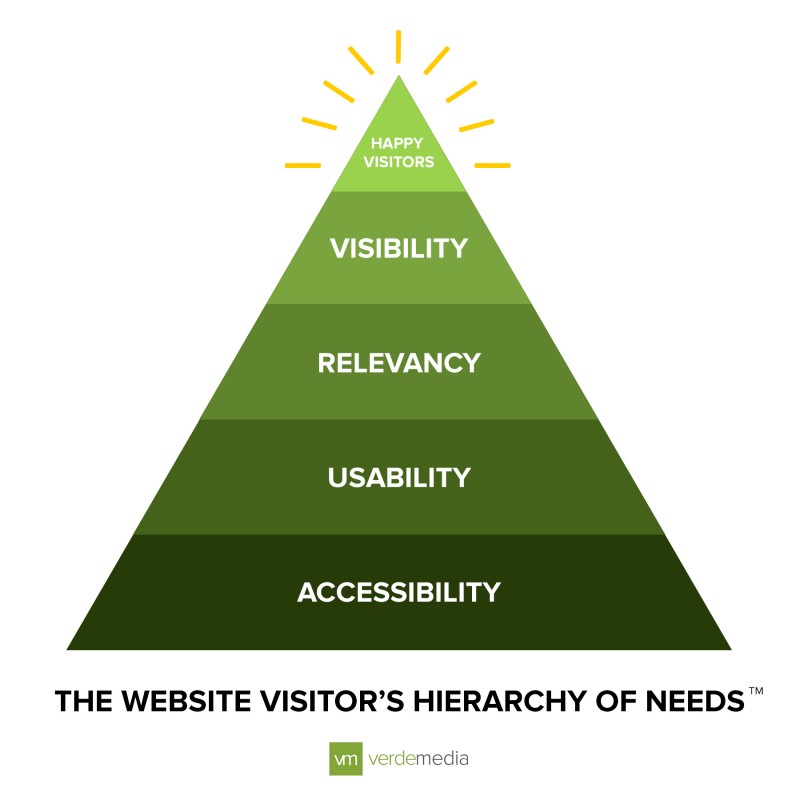Learning Hub | Mindful Marketing
The Website Visitor’s Hierarchy of Needs™ [infographic]
August 19, 2015 | Jon Teodoro

One of the most common questions I get asked is, “What makes a website considered ‘good’?” Is it the design? Is it the speed of the website? Or the amount of traffic it generates? Though it’s a seemingly simple question, the answer is rather complex. The conversation is definitely not something you would want to have with someone while having a drink at a bar. Yawn.
When advising and consulting with clients, a technical answer is sometimes acceptable. But if we can explain things easier, faster, and more clearly, why not?
Back To The Basics
End users don’t care about how well-commented your code is. Nor do they care what typography pairing you used. They instead want to know, “Can this website answer my questions, fulfill my needs, or solve my problems?”
When you think about it in that context, deciding what language to use or what colors you think look best starts to look like an ass-backward approach. Instead, we should be focusing on our users and their needs, and many of those needs can be boiled down to our basic human psychological needs.
The Website Visitor’s Hierarchy of Needs
In 1943, Abraham Maslow proposed a very famous psychological theory called the Hierarchy of Needs, published in the Psychological Review. In his theory, Maslow depicts a pyramid of five basic human needs that need to be fulfilled before a person can take advantage of their full potential.
The way that Maslow explained the complex nature of the human psyche in a simple illustration inspired me to do the same with demonstrating the factors in determining what makes a website “good” or not. Below is what I call The Website Visitor’s Hierarchy of Needs:

Before you can expect your website’s visitors to fulfill your desired objectives though calls-to-action (e.g. sales inquiry, email submission, donations, etc.) you have master the basic needs of your visitors one level at a time, starting from the bottom and moving up until they reach the top of the “pyramid”. As you move up, the “pyramid” gets narrower, indicating that you cannot move onto the next level until you have completely mastered the preceding level.
The Different Levels Explained
Accessibility
In order for a stranger to become a visitor, your website first has to be accessible. There are a variety of things that could hinder your website’s accessibility like server downtime, coding errors, website malware, or misconfigured DNS settings. The dependencies of this need are usually the last thing that users think about although they are often the most important. Without an accessible website, even if a million people could directly access it one would be able to use it.
Usability
Once a stranger becomes a visitor, that’s when the eyeballs start skimming and fingers start clicking. If a visitor can’t read your text or click/tap on buttons and links, you’re missing out on fulfilling their need for usability.
What happens after the click/tap is important, too. If your visitor is brought to a page that doesn’t flow logically with the preceding page, or of the page is confusing or inconsistent with their expectations, then they will probably get frustrated and leave as well.
Moreover, if your mobile visitors have a hard time navigating your site because your site isn’t mobile-friendly, then you also risk losing a large percentage of your traffic.
Relevancy
As a visitor browses your website, its relevancy to the problem they are trying to solve or question they are trying to answer is the next need you have to fulfill. This is where advertising platforms, content publishing platforms, and search engines have made huge evolutionary strides in the recent years by enforcing higher standards of content quality, forcing content creators and SEOs to focus on qualitative factors instead of quantitative factors. Because of this, the number of links or a website has or its PageRank are starting to matter less and things like social popularity and website engagement are starting to matter more.
Visibility
Visibility in advertisements, social media networks, and search engines can only be achieved if your website if you website is relevant to a particular topic and provides a great user experience, provided that it is usable and accessible.
This is normally the part that many business-minded people rush to when thinking about launching a website. They want to be exposed to new markets of customers and want to jump straight into driving traffic without realizing that there are a variety of other fundamental, more important needs that need to be fulfilled. If your website’s visitors feel empty, they will leave. If you can provide them with a reliable platform that can solve their problems, they will stay and likely share your website with others.
Happy Visitors
The top of the pyramid represents your visitors’ psychological state of being fulfilled, thus opening the doors to a reciprocal relationship where they will be willing to do what you want them to do. This could be anything from a phone call to a tweet to an in-person visit to your business. Ultimately, this is the level of ‘transcendence’ that business and website owners strive for.
Tying It All Together
When increased profits or quantitative goals are in the equation, it is easy to get caught up in a metrics-driven mentality. However, business owners, web developers, and content writers alike should never lose sight of the fact that all of the technology and software used in developing a website should be used for one purpose: to make our visitors happy. If we all focused on that, maybe Google wouldn’t have to ‘regulate’ the web as much.
